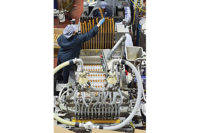Food safety
What the FDA inspectors found inside Blue Bell and Jeni’s ice cream plants; and steps you can take to improve your dairy plant
Read the FDA reports then go through your plant and look for health violations.


Jeni Britton Bauer, founder of Jeni's Splendid Ice Creams


When Food and Drug Administration inspectors toured ice cream plants hit by recalls due to the presence of listeria, they found employees in dirty uniforms, condensate dripping from the ceiling into open ice cream molds, chipped paint, dirty wood pallets and other violations.
Earlier this year, Blue Bell Creameries of Brenham, Texas, recalled all of its products because of the presence of listeria, shut down its factories in Brenham, Broken Arrow, Okla., and Sylacauga, Ala., for cleaning, laid off 1,450 employees and furloughed 1,400 others.
Jeni’s Splendid Ice Creams, Columbus, Ohio, also recalled its products after some were found to be contaminated with the bacteria. (Founder Jeni Britton Bauer is pictured above.)
One food safety expert told Dairy Foods that he does not think it is possible to completely eradicate listeria from a dairy plant. In an article to be published in the June Dairy Foods, Tedd Wittenbrink said “I am of the opinion that if you’re doing these environmental swabs and you’re constantly getting negatives, you’re probably not looking in the right place. I really do believe it’s in every operation, somewhere.” Wittenbrink is the director of integration at Merieux NutriSciences Co., Chicago.
Wittenbrink suggests focusing on four zones: product contact surfaces, other parts of the equipment, walls and floors near the equipment and product, and the warehousing and exterior areas.
“We’re all pretty good at cleaning the equipment,” he said. “It’s the environmental areas that tend to get overlooked — floors, walls, drains, end product and packaging areas. And then control the traffic going in and out of pasteurized areas.”
Dairy Foods reviewed the FDA inspection reports (Form FDA 483) of the three Blue Bell plants and the Jeni’s plant. We summarized some of FDA’s observations from all four of its reports and placed them into categories. Every plant manager should read the full reports (available here), then look at his or her plant through the eyes of an inspector.
An employee with soiled arms and shirt leaned against a package machine during production
EMPLOYEE CLEANLINESS
An employee’s shirt came into direct contact with the interior liner of an ingredient container while the employee was loading the ingredients into a fruit feed. The employee was not dressed in an appropriate outer garment and the shirt appeared soiled with several holes.
A maintenance employee with visibly soiled arms and shirt was leaning on a package machine during production. The arms were extending over exposed product and open packaging.
An employee touched a visibly damp pant leg while wearing single-use gloves, then proceeded to load sleeves of lids without washing hands or changing gloves.
An operator checked the volume in a flavor tank with a metal dipstick, wiped product off the stick with a gloved hand and then returned the dipstick to the tank.
Employees’ shoes are worn in their vehicles and homes and then in sanitary food production areas without any cleaning or sanitizing requirements.
An employee hung an apron so that the apron strings were in direct contact with the prep room floor. Also, a chef coat was lying directly on the floor under the apron.
Condensate dripped into molds which were then filled with ice cream
PHYSICAL PLANT
Ceiling tiles in a mixing room appeared to be stained and broken. A light fixture above the mixing tank had condensate on it.
A continual line of condensate droplets were observed along the bottom of stainless steel product supply lines installed above flavor tanks. Condensate was dripping onto the tops of the enclosed tanks, which were not tight-fitting.
Condensate dripped from hoses into stainless steel molds which were then filled with ice cream.
Paint on a ceiling vent directly above a blender was chipped and cracking.
There is insufficient space in the plant to maintain an adequate flow of employees and equipment through the plant. Employees were observed bumping into each other in the ice cream production room while attempting to perform their duties.
No door foamers, sanitizing mats or similar items in the prep area to protect the floors of the manufacturing areas from cross-contamination from foot, cart and ice cream tote traffic.
A dark brown residue was observed on the underside of a power outlet box on an evaporator unit above prep mix tables.
Apparent dust and dirt were observed adhering to the cap and retaining wire on the fire sprinkler in the hood directly above a kettle used to prepare batches of mix.
Management was unaware that employees were not sanitizing batch freezers
EMPLOYEE ACTIONS
Mix tank operators at a flavor tank containing chocolate ice cream sprayed the tops of the tanks with a water hose which washed the condensate into and around the gaskets, potentially contaminating the ice cream mixes in the flavor tanks.
A mix draw operator removed flavor tank lids and placed them on the tanks, underside up, catching dripping condensate. After ingredients were added to the tanks, the operator placed the lids back over the tanks, potentially contaminating the post-pasteurized ice cream mix with condensate from the lids.
Employees poured orange puree into a flavor tank from buckets stored on wet wood pallets which had black mold-like residue and red stains. They lifted the buckets from the bottom and at times their gloved fingers would contact the top rim and inside of the bucket, possibly contaminating the food contact surface.
Responsibility for assuring compliance with good manufacturing practices relating to personnel was not assigned to competent supervisory personnel. Neither the regulatory manager nor the director of operations was aware that evening-shift employees were not sanitizing food contact surfaces of the inside of the batch freezers at the end of the production day.
Plastic bins containing cocoa powder, sugar and flour were stored beneath sinks used for washing, rinsing and sanitizing raw produce.
The undersides of hopper lids were caked with emulsifiers and stabilizers
EQUIPMENT CLEANING
Pipes, gaskets and other equipment were seen in an employee hand sink immediately following the disassembly of a production line even though a clean-out-of-place tank was available nearby.
There was a failure to provide running water at a suitable temperature for cleaning of equipment, utensils and food-packaging materials. The water temperature was not continuously monitored, verified or documented.
A stainless steel mixer had rough welds and non-continuous welds which could harbor food particles and microorganisms.
Ingredient hoppers in the blending room were not kept clean. The undersides of hopper lids were caked with emulsifiers and stabilizers which had mixed with the humidity in the room. These ingredients and others are blended with raw milk prior to entering the HTST pasteurizer.
Looking for a reprint of this article?
From high-res PDFs to custom plaques, order your copy today!









